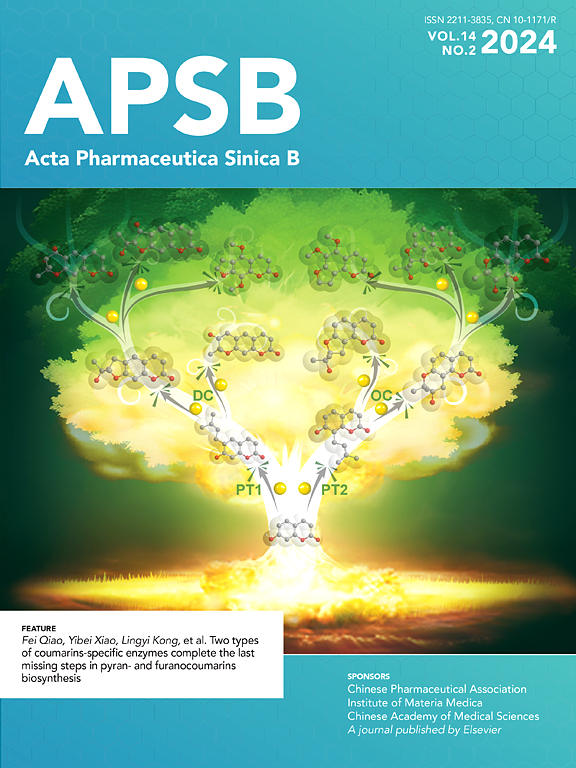STK39 inhibits antiviral immune response by inhibiting DCAF1-mediated PP2A degradation
IF 14.7
1区 医学
Q1 PHARMACOLOGY & PHARMACY
引用次数: 0
Abstract
Evading host immunity killing is a critical step for virus survival. Inhibiting viral immune escape is crucial for the treatment of viral diseases. Serine/threonine kinase 39 (STK39) was reported to play an essential role in ion homeostasis. However, its potential role and mechanism in viral infection remain unknown. In this study, we found that viral infection promoted STK39 expression. Consequently, overexpressed STK39 inhibited the phosphorylation of interferon regulatory factor 3 (IRF3) and the production of type I interferon, which led to viral replication and immune escape. Genetic ablation or pharmacological inhibition of STK39 significantly protected mice from viral infection. Mechanistically, mass spectrometry and immunoprecipitation assays identified that STK39 interacted with PPP2R1A (a scaffold subunit of protein phosphatase 2A (PP2A)) in a kinase activity-dependent manner. This interaction inhibited DDB1 and CUL4 associated factor 1 (DCAF1)-mediated PPP2R1A degradation, maintained the stabilization and phosphatase activity of PP2A, which, in turn, suppressed the phosphorylation of IRF3, decreased the production of type I interferon, and then strengthened viral replication. Thus, our study provides a novel theoretical basis for viral immune escape, and STK39 may be a potential therapeutic target for viral infectious diseases.

STK39通过抑制dcaf1介导的PP2A降解抑制抗病毒免疫应答
逃避宿主免疫杀伤是病毒存活的关键步骤。抑制病毒免疫逃逸对病毒性疾病的治疗至关重要。据报道,丝氨酸/苏氨酸激酶39 (STK39)在离子稳态中起重要作用。然而,其在病毒感染中的潜在作用和机制尚不清楚。在本研究中,我们发现病毒感染促进STK39的表达。因此,STK39过表达抑制了干扰素调节因子3 (IRF3)的磷酸化和I型干扰素的产生,从而导致病毒复制和免疫逃逸。基因消融或药物抑制STK39可显著保护小鼠免受病毒感染。机制上,质谱和免疫沉淀分析发现STK39以激酶活性依赖的方式与PPP2R1A(蛋白磷酸酶2A (PP2A)的支架亚基)相互作用。这种相互作用抑制DDB1和CUL4相关因子1 (DCAF1)介导的PPP2R1A降解,维持PP2A的稳定性和磷酸酶活性,进而抑制IRF3的磷酸化,减少I型干扰素的产生,从而加强病毒复制。因此,我们的研究为病毒免疫逃逸提供了新的理论基础,STK39可能是病毒性感染性疾病的潜在治疗靶点。
本文章由计算机程序翻译,如有差异,请以英文原文为准。
求助全文
约1分钟内获得全文
求助全文
来源期刊

Acta Pharmaceutica Sinica. B
Pharmacology, Toxicology and Pharmaceutics-General Pharmacology, Toxicology and Pharmaceutics
CiteScore
22.40
自引率
5.50%
发文量
1051
审稿时长
19 weeks
期刊介绍:
The Journal of the Institute of Materia Medica, Chinese Academy of Medical Sciences, and the Chinese Pharmaceutical Association oversees the peer review process for Acta Pharmaceutica Sinica. B (APSB).
Published monthly in English, APSB is dedicated to disseminating significant original research articles, rapid communications, and high-quality reviews that highlight recent advances across various pharmaceutical sciences domains. These encompass pharmacology, pharmaceutics, medicinal chemistry, natural products, pharmacognosy, pharmaceutical analysis, and pharmacokinetics.
A part of the Acta Pharmaceutica Sinica series, established in 1953 and indexed in prominent databases like Chemical Abstracts, Index Medicus, SciFinder Scholar, Biological Abstracts, International Pharmaceutical Abstracts, Cambridge Scientific Abstracts, and Current Bibliography on Science and Technology, APSB is sponsored by the Institute of Materia Medica, Chinese Academy of Medical Sciences, and the Chinese Pharmaceutical Association. Its production and hosting are facilitated by Elsevier B.V. This collaborative effort ensures APSB's commitment to delivering valuable contributions to the pharmaceutical sciences community.
 求助内容:
求助内容: 应助结果提醒方式:
应助结果提醒方式:


